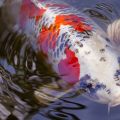WHY KOI BLOODLINES ARE SO IMPORTANT

While those who are new to koi might be comfortable purchasing the first fish they come across, for Veteran koi breeders bloodlines are taken very seriously. This is because buying a fish from a respected bloodline greatly increases the likelihood that they will grow into jumbo quality show fish.
Koi Lineage
Lineage is similar to history; if you don’t know much about the past; it is difficult to consider the future. For instance, if a particular koi fish has Dainichi male parentage, then you’ll need to know the lineage for the Dainichi that the parents are derived from. Understanding lineage also allows you to identify specific characteristics.
For instance, if you’re looking at two koi inside a bowl, one might have acquired a Beni type through its mother, while the other may have acquired its Beni type from the father. The same is true of Kiwa, skin and body type. While learning about lineage can be challenging at first, once you master it you will achieve a level of understanding that most koi collectors and breeders will never reach.
Short vs. Long Term Goals
When buying expensive koi fish with the goal of growing them into big jumbo specimens, there is a difference between short and long term goals. For example, koi collectors that are just looking to buy a fish so that they can take it to a show can take a short term approach. The main criteria they need to look for are a fish that has an excellent body shape with vibrant coloration, exceptional Sashi or Kiwa and an excellent pattern.
However, if you’re searching for a fish that could one day become a grand champion, the koi you’re looking for most likely will “not” have an excellent body shape or color today. What is more important are the bone structure and the shape of its head. You’re searching for clues which suggest this particular fish would grow in a particular way, with a specific weight distribution between the body and shape. With regard to color, you’re searching for something that probably wouldn’t do well at a show if the koi were showcased today, but which has the potential to improve significantly as time passes, peaking once the koi reaches jumbo status. Many of the fish which are presented at shows are only vibrant in color for a short period of time, which will fade long before they fish matures.
Pattern Selection
Most koi collectors look for fish that have patterns which must meet specific criteria, which usually makes the fish showable in the near term. However, those who prioritize bloodlines take a different approach. They can look at a Kiwa and tell whether it will last only for short time, versus kiwa that will continually improve as the fish gets older. For example, Sensuke bloodline koi are known for their straight cut kiwa (which is called Kamisori) though a lot of breeders have Sensuke fish that produce kiwa which is scalloped (Maruzome). Some fish may look too flowery, which is a sign the koi could lose its beautiful pattern as it ages.
Other articles and publications:
- +1 (908) 998-2556
- 205D US-22, Green Brook Township, NJ 08812
- everythingkoi.com







